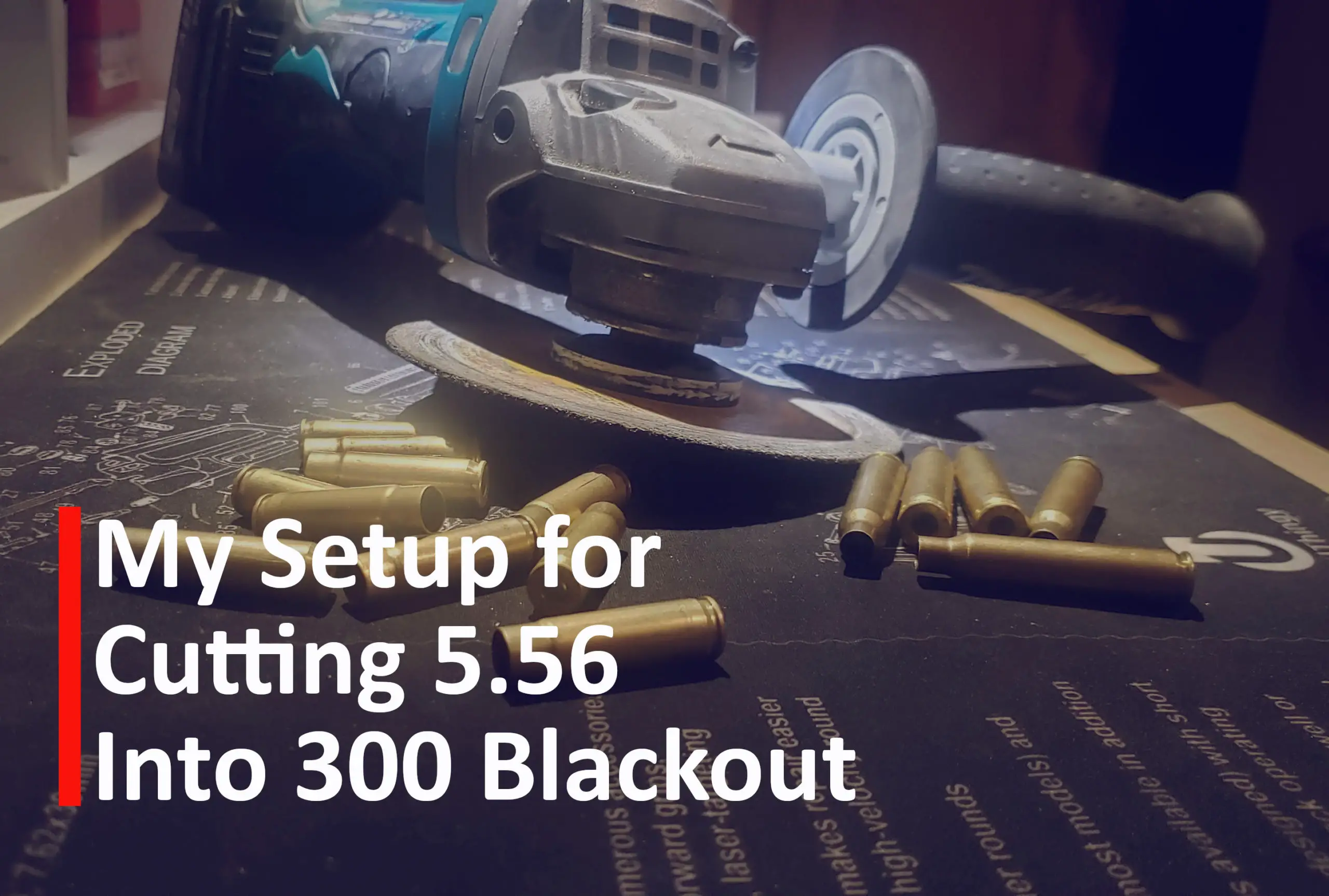My way isn’t the only way to cut down 556, 223, or 204 brass to make 300 blackout. It works though, and I’ve been improving it as we’ve gone along. My favorite part about it is that it works really well for 300 blackout, but it currently doesn’t require any specialized tools. Everything has other uses as well. In fact, most guys probably already have all the tools I use sitting around. I may get a specific setup just for 300 blackout, but right now I like the versatility. I can use my setup for cutting 300 blackout, and for a lot of other things.
The Vise

This is a simple vise on the side of my reloading bench. It doesn’t take a heavy duty vise to hold a little cartridge, but I build to the maximum load I may use it for. After I mounted my vise to my bench I put all my weight on it and it could hold me. That’s good enough for everything I’m currently using it for.

Sizing
I try to cut the brass to 1.38, but I err on the big side. You can cut more off of the 223 or 556 case, but you can’t add. I measured along my vise that length and drew a line with a silver sharpie because that’s what showed up best on the blue vice. When you’re cutting the brass for the first time, you’re doing a rough cut. You want it to be close to the finished size, but not so close that you don’t have room for slipping with your cut off tool.
The Padding
I didn’t want the vise to disfigure my brass as it was clamping it. I’m trying to cut 300 blackout to spec, so squishing it kind of hurts that goal. The padding is a foamy rubbery pad, designed to keep furniture from slipping. It has actually formed to the size of the the cartridge, so its pretty much a jig at this point. I don’t have to use the line at all at this point, but I still like having the line for a good secondary check to make sure I’m in the right spot.

The Cut Off Tool

I use a makita 18v grinder with a cutoff wheel for this. I’ve used a couple corded options in the past but I was always having to move the cord out of the way. I was always worried that I would get careless one day and accidentally cut the cord. I don’t really want to shock myself, so I eventually got the 18v Makita grinder. I love Makita’s 18v tool system. Almost everything they make for that is fantastic.
I also like to have a nonelectric hand tool for everything I use and I have used a hacksaw with this system. It certainly wasn’t as nice to cut, but it worked. If you like a nonpower option, setting up with the vice is the way to go. As I said, it was rough going, but it worked.

For the rest of my methodology for cutting down 300 blackout brass, check out my conversion article HERE.
Option 2- The More Popular Cutting Method
This way is certainly more efficient, but it requires more specialized tools. If you’re going to be mas producing brass, this is what you’re looking for. If you only want to pump out a couple hundred every now and then, you might want to go with the option without the specialized tools.
Cutoff Saw

This is a small cutoff saw that is mostly used in smaller applications. It works perfectly for brass cutting and is the preferred method among people who home manufacture their own 300 aac blackout from 223 or 556 brass. Harbor Freight offers a cut off saw, but if you’re cutting enough volume that you want to get a jig and this setup, get yourself a higher quality saw.
The Jig
They have a jig specially made for this type of work. It’s available from Zep Reloading who really ought to sponsor us (No, we don’t believe in subtlety). This method is a bit quicker than the method I use, but honestly I don’t cut enough yet to justify getting the cutoff saw and jig. I already had the other tools on hand when I started and it got the job done pretty well.

This article is really only looking at cutting the brass. For more on the full process of converting the brass, click HERE.
Keep Learning
Prepping is an ongoing venture. Because of this, we recommend that you subscribe to our bimonthly newsletter to keep prepping, emergency preparedness, and self reliance on your mind. We promise, we’re not spammy, which is why we only email you twice per month. We hope you think about being prepared more than twice per month, but our newsletter is a valuable resource to help you learn new things, and just to keep prepping on your mind. Right now you can also sign up for free. You can also follow our Facebook Page for regular articles and resources.

Amazon does not sell firearms… sort of. It comes really close with some of these items. There are the most dangerous and lethal weapons I found available on amazon that anyone can purchase… READ MORE

We recommend having a 6 month emergency fund. This may require you to utilize your food storage, and you may need to cut spending in a similar way that you would if stores were closed. It can take…. READ MORE



1 thought on “My Setup for Cutting 5.56 Into 300 Blackout”
Comments are closed.